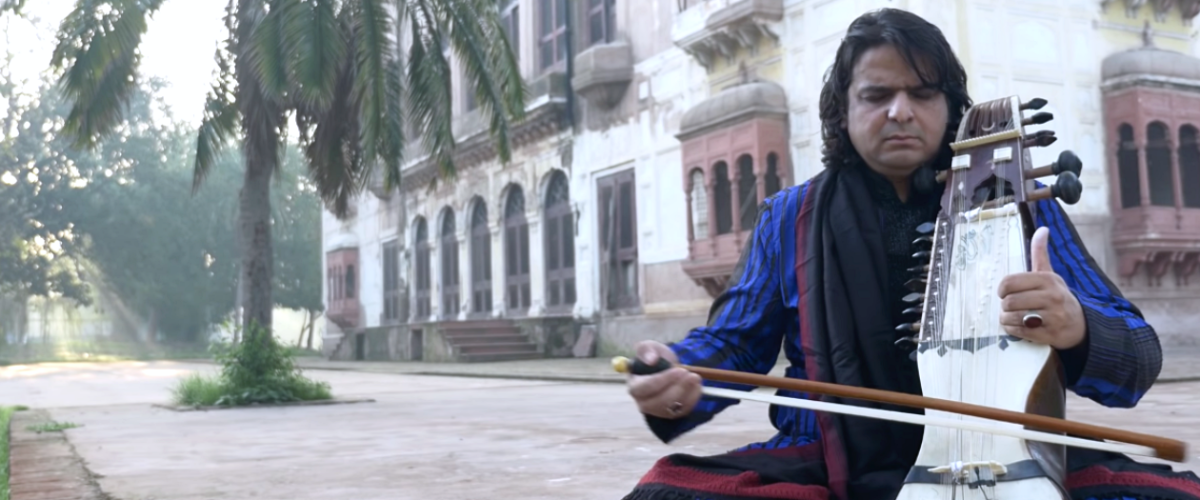

The sarangi is a short-necked string instrument of North India, played with a bow. It is thought to have evolved from traditional stringed and bowed instruments of Rajasthani folk music with subsequent modifications during the period of Mughal rule in North India. Of all Indian instruments, its mournful, hauntingly romantic sound is considered to be not only closest to the human voice in terms of its tonal quality, but also malleable enough to replicate particular kinds of gamak (ornamentation) and meend (slides) normally only possible with human vocal chords.
As such, it was considered an ideal instrument for the accompaniment of vocal music – India’s highest musical form – but this turned out to be a mixed blessing. Because of its tremendous success in this role, for centuries the sarangi (and its close relations the saranda and dilruba) remained an accompanying instrument. Its exponents were relegated to a lowly status in the classical music hierarchy being required to play second fiddle – quite literally – to vocal artists.
Usually measuring around two feet long and just six inches wide, the instrument is carved from a single block of cedar wood into a box-like shape with three hollow chambers named after body-parts: pet (stomach), chhaati (chest) and magaj (brain). It is thought that the ang in the word sarangi refers to the human body, whilst sar means head, the whole word colloquially meaning an instrument that can perform in any style – literally, from head to toe.
The three main playing strings – made of comparatively thicker gut – are stopped not with the finger tips but with the nails or cuticles which have to be lubricated to ease movement. There can be up to 37 sympathetic strings which create a rich resonance underneath the main melody strings.
The sarangi’s fortunes were waning by the start of the 20th century, with the ending of royal patronage for classical music necessitating more long distance travel for musicians and the more portable harmonium becoming the preferred choice for vocal accompaniment. The sarangi’s strong association with kathak dance also took its toll when that dance itself fell into disrepute. But, by the later part of the century, thanks mainly to the efforts of Pandit Ram Narayan, the sarangi began to emerge as a fully-fledged solo instrument paving the way for hereditary players like Ustad Sultan Khan to also make their mark as soloists.
In this solo phase, after having accompanied the greatest vocalists for several generations, the sarangi repertoire was almost entirely modelled on the khayal (Hindustani vocal) repertoire of which sarangi players – more than any other instrumental accompanists – usually have a great in-depth knowledge.
Listen to the music | Kamal Sabri carries his family’s musical tradition forward to a seventh generation, having absorbed the rich Senia gharana from his father, esteemed Moradabad sarangi master Ustad Sabri Khan. Here he plays Raag Shree, recorded by Darbar on location in India.
Jameela Siddiqi is an author, linguist, and BBC cultural commentator, specialising in postcolonial fiction and the devotional music of South Asia.
Darbar believes in the power of Indian classical music to stir, thrill, and inspire. Explore our YouTube channel, or subscribe to the Darbar Concert Hall to watch extended festival performances, talk and documentaries in pristine HD and UHD quality.
Khayal is now the most dominant form of North Indian classical vocal music. The word (also spelt khyal) comes from...
Read More 
The veena, also known as the been in North Indian languages, is a large plucked lute. It is undoubtedly one of...
Read More 
The lifeblood of all Indian classical music, whether Hindustani (North Indian) or Carnatic (South Indian), is the...
Read More 
The beginner's guide to Indian classical music. Whether you’re completely new to raga music or just need a refresher, we’ve put together this brief overview of all things raga music to help you feel at ease when visiting one of our concerts or watch our videos on our YouTube or our Darbar Concert Hall.

Keep up to date with the latest news, events, music and musings across our social channels
For hundreds more clips and shorts, vist our YT page here 
Be the first to hear before events go on sale. Get the latest news and articles from Darbar